Update! As a result of this review, Eartheasy, the North American distributor of the Lifestraw, sent me a few products to try out, and I appreciate when a company is willing to stand behind its products like that. I still feel that the Lifestraw itself is less useful than its fans make it out to be, and that the bottled version is the only version hikers and travelers should consider purchasing. I’ve given specific comments on the bottled version down below, which is worth a look as a portable filter for hiking and other outdoor activities.
As many of you may know, clean drinking water is kind of a big deal. The fact that nowadays we can get drinkable water, right at home, practically for free, is a downright revolutionary (and thoroughly recent) development, and one which remains entirely out of reach for billions throughout the world.
Enter the Lifestraw: A small, lightweight, portable, durable, relatively inexpensive filtration device that can hang around your neck like a necklace, providing you with filtered water wherever you go. It has won an endless string of accolades, and has even been called “one of the ten things that will change the way we live,” with legions of adoring fans singing its praises, swearing by its use in situations of all sorts.
Unfortunately, I think it’s bizarrely overrated.
What’s the Lifestraw?
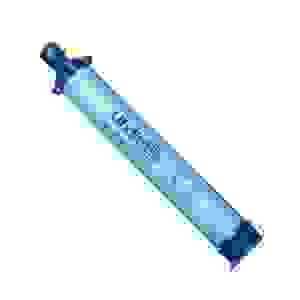
The Lifestraw is a hollow-membrane filter built into a straw. You place the straw into the water, and drink. Sucking the water up through the straw forces it through the filter, which removes 99.9999% of bacteria, and 99.9% of protozoa, down to 0.2 microns, with a filter that lasts for 1000 liters, for about $20. Not bad, right?
That’s pretty good, but on the downside, it won’t remove microscopic minerals, chemicals, or viruses.
This isn’t necessarily a deal-breaker, since most water will be fine, especially if you’re just filtering river water to avoid getting sick…but this thing was designed for the third world, with viruses all over the place, meaning you’d need iodine or other methods to eliminate the potential threat of viral diseases.
It’s certainly better than nothing, and preventing most water-borne diseases is better than preventing none. The Lifestraw was designed to provide excellent filtration at a reasonable cost, which is probably more effective than providing perfect filtration at a high cost, which could very well be too expensive to accomplish its own goals of third world disease reduction. Again, missing the viruses isn’t a deal-breaker, and it can prevent a huge number of water-borne diseases from infecting at-risk populations, but people talk about this thing like it’s the messiah of water filters.
But that’s not even the most annoying part.
The weird problem no Lifestraw review ever seems to mention
I have gone over this problem again and again in my head, looking at the endless cavalcade of glowing Lifestraw reviews, “Invention of the Century” accolades, and legions of ardent fans, and cannot fathom why no one seems to notice or care.
Take a look at the snazzy in-action shot of a guy using the Lifestraw out in the real world:

What happens when you walk away from the water?
No more water.
So if you’re heading into riverless mountains, or the desert, or a 12 hour bus ride in body-temperature heat, or any other situation in which you won’t have access to water, you’ll have to fill up a water bottle ahead of time, and whenever you want a drink of water, you have to:
- Open the bottle
- Open the Lifestraw’s top cap
- Open the Lifestraw’s bottom cap
- Stick the Lifestraw inside
- Drink
- Take it out
- Expel the remaining water
- Close the top cap
- Close the bottom cap
- Close the bottle.
And then…you’ve got a wet Lifestraw, so you’ll probably end up with wet clothes. Sexy!
People talk about how “simple” this is, as if handling three caps instead of one is somehow…simple?
On a related note, imagine traveling with this thing, and trying to fill up from a sink. You’d have to plug the sink, fill it up, wait for it to get deep enough to drink, then take a few sips, unplug the sink, and walk away. Imagine being incredibly thirsty and trying to do this in a hurry. Now imagine you’re about to get on a 12 hour bus ride through midday temperature highs, and all you had ahead of time was a quick sip from the sink, and that’s all you’ll have until the next time you get to another sink, when you’d begin the sink plug process anew. Just for one sip.
Seriously, has anyone actually used this thing?
What the Lifestraw should have been
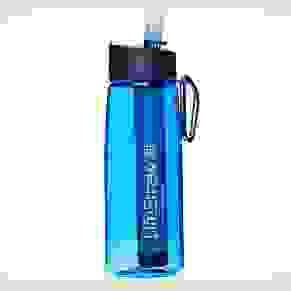
So here we finally are, at a product that’s actually recommendable. The Lifestraw Go. They took the Lifestraw and stuck it inside a water bottle, which eliminates the pointless inconvenience of only being able to drink with water nearby, or having to deal with three different caps and two separate objects for every sip.
But damn…the Lifestraw has been around since about 2005, and this bottled version only started shipping around 2013. This means that for 8 long years, nobody ever bothered asking “Dude, what if you walk away from the river but you’re still thirsty?” Sigh.
This bottled version was designed for the consumer market, which makes a lot of sense, and it’s true that shipping a million regular Lifestraws to disaster zones or poverty-stricken rural areas is logistically easier than shipping a million bottled Lifestraws, as they’d need maybe 5 or 6 times as many shipments due to the size, but damn…how does anyone use the regular one more than a few times without going crazy?
While it’s true that the original Lifestraw was designed for simplicity, portability, durability, and ease of use (and somewhat succeeds), I just can’t see many good reasons not to stick it inside a water bottle in the first place. Particularly from a consumer standpoint, the bottled version is clearly the correct answer here.
Update: I can think of ONE situation in which the straw by itself might be more useful than a bottle: Trail running, near a river. You can strap it to your leg, so it doesn’t bounce around, and you’re always near an outdoor water source, which would only need this type of filtration, and wouldn’t need a bottle.
But, ranting aside, is it a good filter? Is it a cost-effective solution to commonplace water purification needs, third world or otherwise? Could this be the one and only water purification method you employ, whether hiking in the mountains, or adventuring throughout the developing world?
Well…maybe.
Remember, it still can’t filter viruses, which is what you’d want in developing countries.
That’s not to say it’s not useful. A $35 water bottle that provides 0.2 micron filtration which lasts for 1000 liters certainly isn’t bad.
But on the other hand, you can just get the Sawyer Water Bottle, which manages 0.1 micron filtration for a guaranteed 3.7 million liters for a one-time cost of $50.
Um…tell me again, why is the Lifestraw so popular?
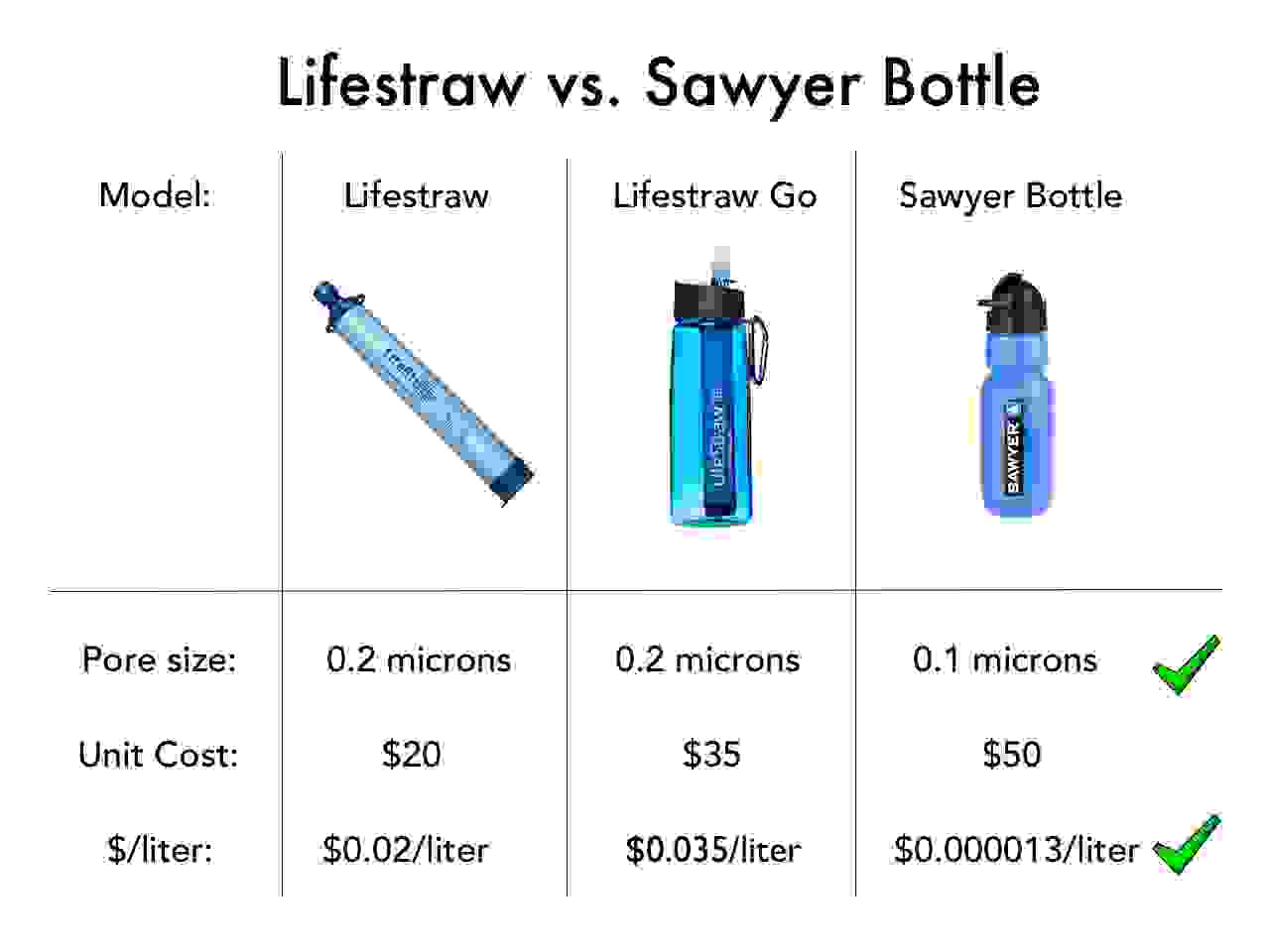
It has been claimed that the Lifestraw’s lifespan estimates are intended to be a little on the safe side, using low-quality water for all of its tests, which is good (and Sawyer’s lofty claims were put to the test, and were sadly shown to come up short, so the performance difference is likely to be smaller than what is claimed). And again, it’s not that it’s bad, and the filtration quality will probably work just fine if you’re hiking in North America, and you could supplement it with iodine tablets if you ever take it with you to Mexico, or wherever else you might want anti-viral protection. And if you’re drinking a liter of water per day, a $35 Lifestraw Go will last almost 3 years, which isn’t bad at all, and if you’re only using it for camping trips on weekends, it’ll last much longer. I also think it looks nicer than the Sawyer. So it’s definitely good; it’s just not necessarily the best, neither on filtration quality, nor on cost-effectiveness.
Update: After receiving and using the Lifestraw Go, I can say that it’s a pretty good product for hikers who plan on filling up from a river and just want a simple water bottle filter to do the job. Its filtration performance isn’t as strong as the Sawyer, nor is it as cost-effective, but it’s still effective and affordable, for non-viral filtration. Keep in mind it’s supposed to filter biological contaminants rather than chemical, meaning it’s more suited to filtering clear river water than tap water, which is more likely to have chemicals of some sort.
Two issues: Firstly, the Lifestraw Go does not use the regular Lifestraw as a replacement filter, but instead uses a slightly modified version. This means you cannot replace the filter inside the Lifestraw Go with a regular Lifestraw, and, at the moment anyway, you cannot buy just the replacement filter by itself. When your Lifestraw Go reaches the end of its life, you’ll have to buy an entirely new bottle. I expect that if the product is successful that they will offer those replacement filters by themselves, but it’s worth being aware of this issue.
Secondly, when the bottle is shut and the straw is folded down, it protrudes slightly beyond the edge of the lid, and it’s easy to get your grubby hands all over the straw when you pick up the bottle, potentially getting the straw a little dirty and thus defeating the purpose of drinking filtered water. This could be easily fixed, and I hope they do it. Second update: THEY DID!
If you think it’s for you, check it out here.
But again, neither of these devices will provide chemical or viral filtration. If you want to get rid of viruses, then you’ll need iodine tablets, or a UV light, or upgrade to a water bottle that actually gets rid of viruses, too.
What if I need serious purification?
For most people, high-quality filtration works just fine. If you’re hiking in North America or filtering tap water while traveling through modern countries, you probably don’t need virus removal to be safe. But if you’re traveling in developing countries with incredibly questionable tap water, you might want to take some extra precautions.
And yes, you can fit a whole purifier right inside a water bottle, like these do:
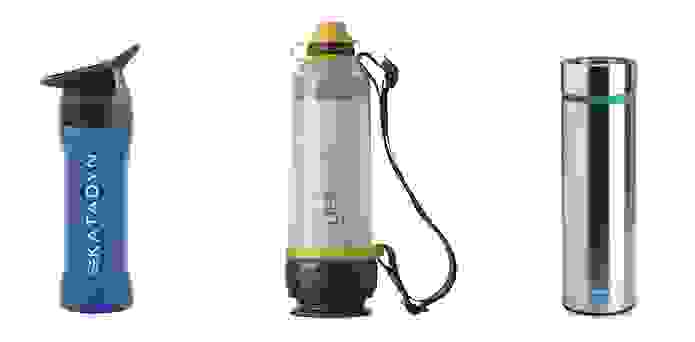
Each of these will clean out viruses, along with all the other contaminants, including chemical, that you’d want removed, providing thorough filtration beyond anything the Lifestraw can manage. Check out a thorough review of those three, including short and long term cost estimates, and suggested uses for each. They all work differently, without any objectively “best” option, so you’ll want to find a favorite that works for you. I’m currently using the GRAYL, which manages the nice trick of allowing multiple options for filtration quality as needed, and also looks nice and classy.
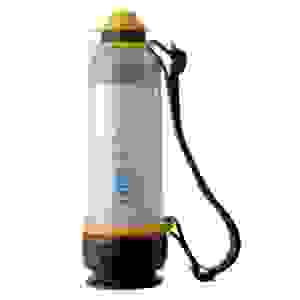
But I’d also like to highlight a close competitor to the Lifestraw, one which shares the design goal of providing high-quality, portable, durable water filtration to vulnerable populations in the third world, and which demonstrates what the Lifestraw could have been. It’s the Lifesaver Bottle, and it’s 13 times better.
The pores in the Lifestraw are 0.2 microns, whereas the pores in the Lifesaver are 0.015 microns, making them about 1/13th the size, which is small enough that viruses can’t get in. No more worrying about having to use iodine tablets.
It’s true that the Lifesaver is bigger, heavier, bulkier, and significantly more expensive (though long-term costs are actually quite good), whereas the Lifestraw was supposed to be so tiny and portable that you can take it with you wherever you go, which might actually mean it gets used more frequently by those who don’t want to bring along a bottle all the time. But…if you need a bottle anyway, and you want portable virus filtration, the Lifesaver wins.
Yet nobody seems to know it exists.
So why does everyone love the Lifestraw?!?!
Well, I don’t really know. It was even called the “Invention of the Century,” from a publication I otherwise enjoy, despite lower performance and higher long-term cost than competing options that have been on the market for years.
Again, it’s not bad, and the bottled version solves quite a bit of the silly ridiculousness of the straw-only version, but everyone adores the straw-only version, as a consumer product, which is absolutely inexplicable to me.
But I have a theory:
At $20, it’s cheaper than many other filters, and, admittedly, its filtration capability is pretty good, and a lot better than most of what I’ve seen for the same initial cost. It has a nice impulse-buy price point that gets people interested, and its unique design sets it apart in a world of filtered pitchers, faucet adapters, and so on. And when it arrives in the mail, people give it a try, drinking from a cloudy glass of water, and impressing some friends. Buyers are left happy.
And then they never use it.
Seriously. If you read the Lifestraw reviews on Amazon, you’ll see lots and lots of people talking about how great it is, who stuffed it into an emergency preparedness kit and never bothered with it again. They’re rating the product on how cool they think it is, not how practical it is in real-world use.
People actually love it so much that they videotape themselves drinking from jars of water full of feces…which is explicitly something the Lifestraw cannot handle, because water contaminated this way can easily have viruses inside, which the Lifestraw is incapable of removing. There’s a level of enthusiasm for this product that is literally dangerous.
So is the Lifestraw useful at all?
I would like to clarify that I am examining the Lifestraw from a consumer standpoint, rather than from a disaster-relief or third world disease alleviation product. It offers plenty of functionality in those situations, especially the Lifestraw Family, which is a larger (though still portable) filter intended for home use that does remove viruses. Most of my annoyance should be directed toward the overrating fanboys, who post videos of people drinking toilet water, and then resort to third-grade name-calling if anyone ever criticizes its performance or design.
So it’s certainly not horrible, particularly the bottled version, which is the only one you should bother looking at. Its filtration capability is actually quite good, and it’s pretty convenient. I just think it has been played up way too much in the media, and people salivate over it like it’s this work of art that no disaster-preparedness kit should ever be without.
Just remember that it is incapable of handling chemical and viral contamination, meaning you should only use it within a narrow band of circumstances; outdoor recreation, in North America (and similar settings), where the water you come across has neither chemicals nor viruses.
So it’s certainly worth a look, but I can’t say it’s the best. Competing products provide better filtration at a more cost-effective price, while other devices handle viruses as well, which is what you’d want in developing countries.
Check it out, but remember to…filter some of the adoration.




I was watching a tv program on the weather channel called, “Fat Guys in the Woods”. The survivalist gave the guys a filtering straw, I found it interesting so I checked it out. The we’re lying on the ground drinking water from a stream, which I decided I did not want to do. Anyways, I stumbled upon your reviews and found them informative and entertaining. Do I take your blog as a Holy Bible of information, probably not, I’m a critical thinker. But I went on YOUR blog and your opinions lead me to consider other ideas that you posed. To have constructive criticism is one thing, to name call is just immature on the parts of the person leaving comments. This is YOUR blog if they don’t like it they should just move on to ones they do. I mean really, ” Small penis syndrome” ? Are we children here? I did want to know if you found out about shelf life of the Grayl replacement filters?
Best comment so far.
Hello,
thanks a lor for this review.
I am preparing a hike that should last several days (7-8days), and I was looking at the water filters. My problem is: I am going to need water for cooking meals. And I’m wondering if the LifestrawGo would be useful in this case
If I have only the straw, then I cannot fill the cooking pot. I watched the Earteasy video and the bottom of the straw is not compatible with a normal bottle or a squeeze pouch, and I haven’t found adapters on their website.
So I am wondering: with the LifestrawGo, can I just turn the bottle (with the straw) upside down, and the water should flow down just with gravity. Or do I still need to suck up the straw?
(I also looked at the Puresip mentioned above, but again, the bottom cannot be attached to regular bottles)
I was wondering if in my case the Sawyer mini (can be attached to any bottle or water pouch) was more adapted?
No Lifestraw of any type can fill up anything else; turning the bottle upside down doesn’t put enough pressure on it to move the water through the filter.
You’re right about the Sawyer Mini, though. You can fill up a bottle or a bag and squeeze to push through the filter, so you can fill up other containers, like cookware or other water bottles. Aside from that, the Grayl and Lifesaver can fill up other containers too.
Ok so I was dirt biking in the CO mountains this past week and I ran out of water and was fairly lost. Not tragically lost, but momentarily lost. I got very near to heat stroke: stopped sweating, so confused I took out the map to look at the trail number 3 times in a row and promptly forgot it each time.
Managed to make it back to the vehicle, where the was 4 gallons waiting but it made me realize i need some lightweight filtration device and a small survival kit, and one of the guys that was with on that trip told me about lifestraw so I started to research. Then I found this blog and expanded my research based on suggestions here and elsewhere. I came across the mini and the fact i can splice it into my hydration pack is much more appealing. People (lifestraw lovers but still) that the sawyer mini filter holes will expand and that its overreaching with its estimation of 100,000 gal. What are your thoughts on this? Size is more of an issue than weight and the sawyer mini is much smaller and can fit in my hydration pack inline with the hose, so thats the one I want but the fact that ill use it frequently unlike most armchair survivalists, I want to make sure Im not going to be miles from anywhere and sick.
The thing is, even if the Sawyer fails to live up to its claims, it’s backed by a guarantee, and you can get it at any high-quality sports store, which will also have a guarantee. So if it fails before you reach 100,000 gallons (which, at a gallon of water per day, will take you 273 years), you can walk right in and complain and get a free replacement. But the fact that it comes with an included syringe cleaning system leads me to believe that it’ll last a long time, simply because you can clean it regularly.
Besides, even if its pores expand (which seems weird to me), they start off at half the size of the Lifestraw’s pores (0.1 vs 0.2). Is it really a criticism to say that it will eventually be reduced to the same quality as the Lifestraw? Sounds like if it starts out with a headstart, that’s just a point in its favor, isn’t it? So it offers better filtration, a longer lifespan, all in a smaller size, for about the same price, and you can clip it onto a water bottle or into a hydration bladder hose, and with the Lifestraw you can’t. Seems like an easy decision to me.
Yea lol it was definitely an easy choice. Got it, and once I get my geigerrig it’ll be even better. Thanks for the reply!
bringing along a bottle, canteen or any other carrier for water is not burdensome. It may not be cool, or be an elegant solution, but it certainly is not that difficult….and yes I have used life straw as well as a number of pumps/filters chemicals &c. I find that they all have a place depending on the scenario and that is primarily dependent on the quality of the water. I prefer a filter that not only removes virus but also chemicals, though it isn’t necessary in any place I’ve been stateside.
does anyone have any experience with the different water purification units/systems described as to how well they work with salty/sea water?
I think the idea behind the straw is to have something so compact as to keep on your person, even when you believe you will have no need for it. When 2 hours in the woods becomes 2 days or that short ride in the mountains becomes a long walk back to civilization.
My only criticism of this straw is that there are more compact versions (Aquamira Frontier Emergency Water Filter System) and when carrying something you hope never to use smaller is better since you are more likely to carry it.
I agree the bottle system is better (convenient) if you expect to need it frequently and the pumps are better (cheaper) if you know you’ll need it every time you’re refilling all of your tanks.
I’d personally like an even smaller version, something even closer to a real straw size, even if it was limited to 6-12 gallon capacity making it adequate for 1-3 people for 1-3 days.
Here is the site for the smallest one I could find.
Would still trade gallons of capacity for lower cost.
At 20 bucks a pop I will not be able to hand these out to everyone I know.
But I have ordered 1 for my every day carry, hope I never need it.
Would be a good bon-voyage gift for world travelers.
http://h2osurvivalstraw.com/h2o-survival-travel-straw/
Well someone doesn’t like the lifestraw! The thing about viruses is that they usually require a host to survive so if you think you will catch a virus from drinking water from a stream or whatever using a lifestraw then you shouldn’t really panic. Also you seem to try and magnify slight inconveniences such as ‘oh my shirt might get wet’ and ‘I have to take the cap off the filter boo hoo’. It’s for survival, not everyday use, I think these issues can perhaps be forgiven. You definitely work for one of the rival water filtration companies and you make this far too obvious in your post. The bottom line is that this product has been used, tested and is now widely acclaimed. It wouldn’t have such support if it was a crappy useless item and the fact you think your biased opinion really should take precedence is just idiotic. Third world countries have used them in disaster situations so it appears it does work and there is demand for it so I don’t know how you can be so critical of the Lifestraw.
Again, I’ll just reiterate the superior, cheaper, more convenient options that have far less marketing muscle behind them, and no, I don’t “work for” any of the rivals. I simply recognize how they are superior, cheaper, and more convenient. It seems odd that people get so emotional about these issues, because it’s just a plain and simple fact. The Sawyer filter is objectively superior by every conceivable metric, but people throw a tantrum whenever anyone says so.
You have provided critical information and seems to be a fair and honest review.
As I started to read this, I too thought you were selling another manufactured water bottle better than the lifestraw . As I read on I found that you were merely comparing products. I want to thank you for sharing your valued opinion on the water filtration products. It’s truly a shame that some have turned this into a negative blog comments. Negativity gets us nowhere in life. They must live a miserable life and I am sorry that someone has brought negative comments through out their lives to become a negative person. I hope all of your life journeys continue to be a positive impact on the world and not a negative one.
Thank you. I chose to leave the negative comments there because they only prove my point. People have this bizarre emotional connection to a piece of plastic that just isn’t that great. Seems pretty simple to me, but they get all fussy about it. Thanks for your comments.
What I was thinking but quite inexperienced so I doubted myself. Thank you for posting and for the helpful information. Greatly appreciated mate.
Hi all. Lifestraw is overrated. Try my product UFILTA.
http://www.ufilta.com
Cheers
Avinash